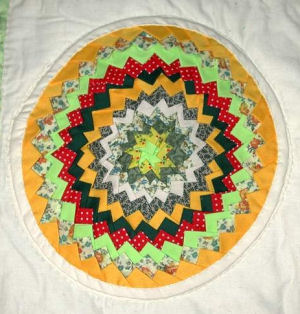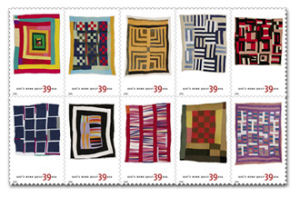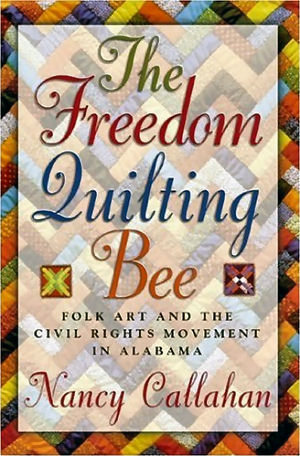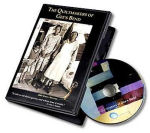Alabama State Quilt
 |
Pine Burr Quilt: Loretta Pettway Bennett
Photograph © by Steve Grauberger
Used with permission |
Adoption of the Official State Quilt of Alabama
The Pine Burr Quilt emanated from a somewhat isolated area of Alabama called Gee's Bend, named after James Gee who layed claim to the area in the early 1800s. About five miles long and eight miles wide, Gee's Bend is bordered on three sides by the Alabama River, about forty miles southwest of Selma. (Gee's Bend was officially named Boykin in 1940.)
In 1845, the Gee family sold their claim to Mark Pettway who moved with his family from North Carolina to Gee's Bend about a year later. Mr. Pettway brought about 100 slaves with him.
When the slaves were freed, many stayed on as planters and sharecroppers. The Pettways sold the plantation in the 1900s. The hundreds of African-Americans in the area remained and were assisted by advice and loans from the Resettlement Administration beginning in 1935.
Because of its isolation, the culture developed over the years with little outside influence. Gee's Bend also attracted curious outsiders.
In the 1941, speech professor and folklorist Robert Sonkin visited Gee's Bend, recording music, recitations, and a Fourth of July Program.
The Civil Rights movement of the 1960s resulted in job loss and diminished income for many African-Americans as they pursued their right to vote during voter registration drives in the area. In 1966, to counteract loss of economic support, Gee's Bend residents created the Freedom Quilting Bee, a hand-craft cooperative that soon captured the attention of fashion designers in New York City and sparked a nation-wide revival of interest in patchwork quilting.
In 1997, in efforts to rekindle interest in the art and inspiration of the quilters of Gee's Bend and to promote the beautiful, hand-crafted art that the quilts expressed, the Alabama Legislature voted, by Joint Resolution No. 177 to name a product of Gee's Bend, the Pine Burr Quilt, the official state quilt of Alabama.
WHEREAS, the Freedom Quilting Bee was organized as an outgrowth of the Civil Rights Movement in 1966, one of the few all Black women's cooperatives in the country; and
WHEREAS, the Freedom Quilting Bee has achieved national recognition for its quilts by using designs that come from 140-year-old tradition; and
WHEREAS, China Grove Myles, a farmer, was the only one left in Gee's Bend who could sew the Pine Burr Quilt, a pattern involving hundreds of tedious swatches that unfold before the eye in a breathtaking, three-dimensional effect; and
WHEREAS, Nettie Young, also a farmer, is the only woman now working at the Bee who was among its originators, and who typifies the history of the Black race in Alabama; and
WHEREAS, quilts and artifacts of the Civil Rights era, which will be presented and stored in the Freedom Quilting Bee, will provide an accurate documentation of the events taking place in American history; and
WHEREAS, a love and understanding of the history of our state are enhanced by traditions that have become a part of our way of life and the customs of the American people, and the official recognition of the Pine Burr Quilt will indeed enhance the cultural stature of Alabama both nationally and internationally; now therefore,
BE IT RESOLVED BY THE LEGISLATURE OF ALABAMA, BOTH HOUSES THEREOF CONCURRING, That in recognition of a meaningful symbol for a state quilt, the Pine Burr Quilt is hereby designated as the official state quilt of Alabama.
BE IT FURTHER RESOLVED, That a copy of this resolution be presented to the Freedom Quilting Bee with sincere best wishes for future success.
Approved March 11, 1997
In 2002, the "Quilts of Gee's Bend" exhibition was launched at the Museum of Fine Arts in Houston, Texas. The exhibition brought 60 quilts, made by 42 Gee's Bend women, to museums in New York City, Mobile and Auburn, Alabama, Milwaukee, Wisconsin, Washington, D.C. Cleveland, Ohio, Norfolk, Virginia, Memphis, Tennessee, Boston, Massachusetts, Atlanta, Georgia, and San Francisco, California.
 |
| American Treasures: Quilts of Gee's Bend |
Michael Kimmelman, chief art critic of The New York Times called the quilts "some of the most miraculous works of modern art that America has produced." [ Review of "The Quilts of Gee's Bend" ]
In 2006, as part of their American Treasures Series, the U.S. government issued a series of stamps commemorating the quilts of Gee's Bend.
"The American Treasures stamp series is intended to showcase beautiful works of American fine art and crafts. For the 2006 issuance, art director Derry Noyes chose photographs of ten quilts created between circa 1940 and 2001 by African-American women in Gee's Bend, AL."
Source: Alabama Department of History & Archives, Official Quilt of Alabama, October 10, 2008.
Source: The Alabama Legislature, October 10, 2008.
Source: National Public Radio, The Quilts of Gee's Bend, October 10, 2008.
Source: The New York Times, ART REVIEW; Jazzy Geometry, Cool Quilters, by Michael Kimmelman. November 29, 2002.
Source: State Names, Seals, Flags and Symbols: A Historical Guide Third Edition, Revised and Expanded by Benjamin F. Shearer and Barbara S. Shearer. Greenwood Press; 3 Sub edition (October 30, 2001).
Additional Information
Official Quilt of Alabama:
Official Symbols and Emblems of Alabama from the Alabama Department of History & Archives.
Pine Burr Quilt Instructions:
Instructions about how to make the Pine Burr Quilt from the Alabama Department of History & Archives. 
Freedom Quilting Bee:
History, activities, and plans from The Rural Development Leadership Network.
Center for Traditional Culture:
from the Alabama State Council on the Arts.
The Quilts of Gee's Bend:
Jeffrey Brown visits a small town in Alabama whose quilts have been discovered by the art world. Online NewsHour [Transcript].
The Quilts of Gee's Bend:
A Showcase of Distinctive Work by African-American Artists, by Neal Conan. National Public Radio.
The Women of Gee's Bend:
All Things Considered: People and Places, by Debbie Elliott. National Public Radio.
The Quilts of Gee's Bend:
Quilters Collective History.
The Quilts of Gee's Bend:
Auburn University's program in Women's Studies undertook an ongoing interdisciplinary project to study the Quilts of Gee's Bend and develop strategies and materials for making them a part of the cultural education of Alabama's - and America's - children..
Commemorative Stamps:
Press: Postal Service Celebrates Quilting Tradition with Quilts of Gee's Bend Stamps, Issued at Largest Annual United States Philatelic Event.
The Freedom Quilting Bee: Folk Art and the Civil Rights Movement,
by Nancy Callahan, 272 pages, Fire Ant Books (April 17, 2005) In December of 1965, the year of the Selma-to-Montgomery march, a white Episcopal priest driving through a desperately poor, primarily black section of Wilcox County found himself at a great bend of the Alabama River. He noticed a cabin clothesline from which were hanging three magnificent quilts unlike any he had ever seen. They were of strong, bold colors in original, op-art patterns--the same art style then fashionable in New York City and other cultural centers. An idea was born and within weeks took on life, in the form of the Freedom Quilting Bee, a handcraft cooperative of black women artisans who would become acclaimed throughout the nation..
The Quilts of Gee's Bend: Masterpieces from a Lost Place,
by William Arnett, Alvia Wardlaw, Jane Livingston, John Beardsley, 192 pages, Tinwood Books (September 23, 2002) The oversize format allows the many full-page reproductions to approximate the sensation of a large quilt spread on the page; the many "Housetop" quilts, with arresting geometric patterns and terrific color sense, speak for themselves. The book and exhibition make an important contribution to American cultural history..
Gee's Bend: The Architecture of the Quilt,
by Paul Arnett, William Arnett, Bernard Herman, Maggi Gordon, Diane Mott, Dilys Blum, Lauren Whitley, Amei Wallach, Joanne Cubbs (Author), 224 pages, Tinwood Books (July 25, 2006). Gee's Bend: The Architecture of the Quilt is a major book and museum exhibition that will premiere at the Museum of Fine Arts, Houston (MFAH), in June 2006 before traveling to seven American museums through 2008. The book's 330 color illustrations and insightful text bring home the exciting experience to readers while displaying all the cultural heritage and craftsmanship that have gone into these remarkable quilts.
The Quilts of Gee's Bend,
DVD, 28 minutes. Region 1. The Quilts of Gee's Bend documentary accompanies the major exhibition of the same name. Set in the quiltmakers' homes and yards, and told through the women's voices, this music-filled, 28-minute documentary takes viewers inside the art and fascinating living history of a uniquely American community and art form..
The Quiltmakers Of Gee's Bend,
DVD from Alabama Public Television, 60 minutes. Region 1 (U.S. and Canada only.)
|






